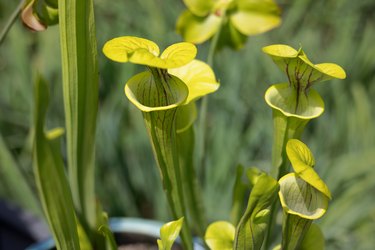
With over 700 varieties, carnivorous house plants have the ability to trap and digest living creatures. Though some carnivorous plants are large enough to capture small animals such as mice and frogs, most feed on small insects such as ants. The tropical pitcher plant (Nepenthes spp.), grown in U.S. Department of Agriculture plant hardiness zones 11 to 12, and the American pitcher plant (Sarracenia spp.), grown in USDA zones 6 through 11, are two genera that have the ability to attract and digest cockroaches and can be grown as houseplants when the proper conditions are provided.
Native Carnivorous House Plants Habitat
Video of the Day
Tropical pitcher plants are found growing wild in southeast Asia. As with other carnivorous plant varieties, pitcher plants are commonly found in swampy areas where the nutrients in the soil are limited. Though carnivorous plants do photosynthesize, the process by which plants convert energy from light into energy the plant can use, the insect meals they digest provide the supplemental nutrients they need to thrive.
Video of the Day
Tropical Pitcher Plants
The pitchers of a tropical pitcher plant are bowl-shaped. A circular opening with a flap over the pitcher remains open. The nectar on this flap attracts the prey to the plant. Once the insects enter the pitcher, they become trapped by the slippery surface and slide deeper inside. At the interior base of the pitcher, a pool of slime with digestive enzymes enables the plant to feast on the nutrients the insect provides. Tropical pitcher plants are capable of feasting on a cockroach because of their size and structure.
American Pitcher Plants
The American pitcher plants have pitchers that grow upright similar to a tube. Inside the pitcher, hairs with nectar point downward. The nectar attracts insects that become trapped inside by the slippery and steep surface of the pitcher. While American pitcher plants may be able to digest a small cockroach, too much weight in the upright pitchers can cause them to topple over -- so it is best not to manually place one in the pitcher.
Other insects such as cockroaches can be attracted to the pitcher from the odor produced as smaller insects are digested, advises Carnivorous Plant Nursery. However, while cockroaches may be consumed by the pitcher plant, it is unlikely that most cockroaches will climb up into the pitcher, and owning these plants is not a practical method of roach control in your home.
Growing Pitcher Plants
Pitcher plants require summer daytime temperatures between 70 and 75 degrees Fahrenheit and winter temperatures between 55 and 60 degrees F. They need high humidity and bright light with at least one to two hours of direct light each day. A lack of humidity can prevent the pitchers from forming properly, notes the Carnivorous Plant Nursery. This environment can be created indoors by placing the plant in a sunny window or using a grow light.
The growing medium should be a 1:1 mix of sphagnum peat moss and clean play sand; only plant in containers with drainage holes. Place a tray underneath the potted plant and keep water in the tray at all times to prevent the soil from becoming dry. As water leaves the soil from evaporation and through plant use, the soil can absorb more water from the tray through the drainage holes of the container. Only use rainwater or distilled water to avoid the minerals that may be present in tap water. Due to the plants' preference for poor-quality soils, fertilizing is not necessary.